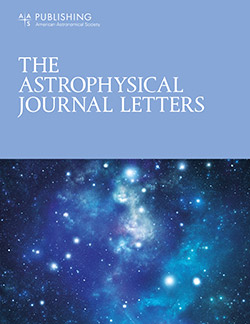不再拥挤:用JWST对造父变星的高分辨率观测测试哈勃常数的准确性
IF 8.8
1区 物理与天体物理
Q1 ASTRONOMY & ASTROPHYSICS
引用次数: 7
摘要
高分辨率的詹姆斯韦伯太空望远镜(JWST)观测可以测试哈勃太空望远镜(HST)观测的光度偏差,这种偏差可能影响星系外造父变星和哈勃常数的确定。我们利用JWST NIRCAM对NGC 4258(基于脉塞的几何距离为1.5%)和NGC 5584(超新星Ia 2007af的宿主)中320颗造父变星的两个历代和三个滤光片进行了观测,这两颗造父变星接近SH0ES HST超新星Ia宿主样本的中位数距离,是检测这种偏差的最佳工具。JWST在近红外波段提供了比HST更好的源与视线同伴的分离,在很大程度上消除了这些波长的混淆或拥挤噪声,在这些波长的消光最小。结果是造父变星周期-光度关系的色散显著降低了2.5倍,从0.45等降至0.17等,将单个造父变星的精度从20%提高到7%。两历元光度法确认了鉴定,测试了JWST光度稳定性,并限制了造父变星的相位。P - L关系截距非常吻合,NGC 4258和NGC 5584的JWST - HST差值分别为0.00±0.03和0.02±0.03等。HST和JWST从这些截距中测定h0的差异为0.02±0.04 mag,由于阶间误差抵消,对JWST零点或计数率非线性不敏感。我们探索了广泛的分析变量(包括通带组合,相位校正,测量的探测器偏移量和拥挤水平),表明稳健的基线结果。这些观测结果提供了迄今为止最有力的证据,证明HST造父变星光度测量的系统误差在目前的哈勃张力中没有发挥重要作用。即将到来的JWST对12sn Ia宿主的观测将进一步完善哈勃常数的局部测量。本文章由计算机程序翻译,如有差异,请以英文原文为准。
Crowded No More: The Accuracy of the Hubble Constant Tested with High-resolution Observations of Cepheids by JWST
Abstract High-resolution James Webb Space Telescope (JWST) observations can test confusion-limited Hubble Space Telescope (HST) observations for a photometric bias that could affect extragalactic Cepheids and the determination of the Hubble constant. We present JWST NIRCAM observations in two epochs and three filters of >320 Cepheids in NGC 4258 (which has a 1.5% maser-based geometric distance) and in NGC 5584 (host of SN Ia 2007af), near the median distance of the SH0ES HST SN Ia host sample and with the best leverage among them to detect such a bias. JWST provides far superior source separation from line-of-sight companions than HST in the near-infrared to largely negate confusion or crowding noise at these wavelengths, where extinction is minimal. The result is a remarkable >2.5× reduction in the dispersion of the Cepheid period–luminosity relations, from 0.45 to 0.17 mag, improving individual Cepheid precision from 20% to 7%. Two-epoch photometry confirmed identifications, tested JWST photometric stability, and constrained Cepheid phases. The P – L relation intercepts are in very good agreement, with differences (JWST−HST) of 0.00 ± 0.03 and 0.02 ± 0.03 mag for NGC 4258 and NGC 5584, respectively. The difference in the determination of H 0 between HST and JWST from these intercepts is 0.02 ± 0.04 mag, insensitive to JWST zero-points or count rate nonlinearity thanks to error cancellation between rungs. We explore a broad range of analysis variants (including passband combinations, phase corrections, measured detector offsets, and crowding levels) indicating robust baseline results. These observations provide the strongest evidence yet that systematic errors in HST Cepheid photometry do not play a significant role in the present Hubble Tension. Upcoming JWST observations of >12 SN Ia hosts should further refine the local measurement of the Hubble constant.
求助全文
通过发布文献求助,成功后即可免费获取论文全文。
去求助
来源期刊

Astrophysical Journal Letters
ASTRONOMY & ASTROPHYSICS-
CiteScore
14.10
自引率
6.30%
发文量
513
审稿时长
2-3 weeks
期刊介绍:
The Astrophysical Journal Letters (ApJL) is widely regarded as the foremost journal for swiftly disseminating groundbreaking astronomical research. It focuses on concise reports that highlight pivotal advancements in the field of astrophysics. By prioritizing timeliness and the generation of immediate interest among researchers, ApJL showcases articles featuring novel discoveries and critical findings that have a profound effect on the scientific community. Moreover, ApJL ensures that published articles are comprehensive in their scope, presenting context that can be readily comprehensible to scientists who may not possess expertise in the specific disciplines covered.
 求助内容:
求助内容: 应助结果提醒方式:
应助结果提醒方式:


